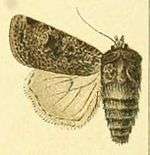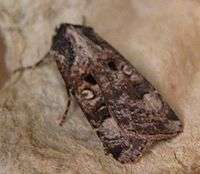Agrotis trux
| Agrotis trux | |
|---|---|
 | |
| female | |
 | |
| male | |
| Scientific classification | |
| Kingdom: | Animalia |
| Phylum: | Arthropoda |
| Class: | Insecta |
| Order: | Lepidoptera |
| Family: | Noctuidae |
| Genus: | Agrotis |
| Species: | A. trux |
| Binomial name | |
| Agrotis trux (Hübner, [1824]) | |
| Synonyms | |
| |
The Crescent Dart (Agrotis trux) is a moth of the Noctuidae family. It has a Circum-Mediterranean distribution and is found along the coasts of France, Ireland, England, South Europe, Algeria, Syria, Iraq, Iran South Russia and the Arabian Peninsula. In Africa, it is found as far south as South Africa.

Description
The wingspan is 35–42 mm. Forewing ochreous grey, dappled and striated, and often, especially in the females, suffused with dark fuscous; claviform stigma black-edged; reniform large, filled in with black; orbicular small, round, with a pale ring; fringe rufous; hindwing dull whitish, with fuscous terminal suffusion, broader in female; or with a curved row of dark dashes on veins and no suffusion; a variable species, occurring throughout S. Europe, in Algeria, the Canaries, S. Russia and Asia Minor; — in ab. olivina Stgr. the forewing is smooth olivegrey, with no or little irroration, the markings concisely red-brown: - ab. terranea Frr. has the suffusion and markings rufous; — ab. amasina Stgr. is fuscous grey, with blackish median shade, the ground colour darker in the female; — subsp. lunigera Stph. Forewing fuscous or pale grey, varied with yellowish; the lines distinct; orbicular stigma small; reniform large, and blackish; claviform black; occurs on the south coast of England and Ireland; — ab. pallida Tutt is whitish grey with a slaty tinge, not irrorated with yellow; — ab. virgata Tutt with a dark shade before reniform stigma and the outer third of wing dark; — ab. suffusa Tutt has the whole wing suffused with , blackish grey, except the pale orbicular and a small patch between reniform and outer line; — ab. nigra Tutt has the forewing unicolorous blackish, the lines and stigmata more intense, the orbicular sometimes visible; — and ab. rufescens Tutt like the type but tinged throughout with reddish.[1]
Biology
Adults are on wing in September to April. There is one generation per year.
The larvae feed on the roots of various herbaceous plants, including Taraxacum and Polygonum.[2]
Subspecies
- Agrotis trux trux
- Agrotis trux lunigera (Great Britain)
References
- ↑ Seitz, A. Ed., 1914 Die Großschmetterlinge der Erde, Verlag Alfred Kernen, Stuttgart Band 3: Abt. 1, Die Großschmetterlinge des palaearktischen Faunengebietes, Die palaearktischen eulenartigen Nachtfalter, 1914
- ↑ "Robinson, G. S., P. R. Ackery, I. J. Kitching, G. W. Beccaloni & L. M. Hernández, 2010. HOSTS - A Database of the World's Lepidopteran Hostplants. Natural History Museum, London.".
External links
- Lepiforum
- Funet Taxonomy
- Fauna Europaea
- Noctuinae of Israel
- UKmoths
- Synonymous Checklist of the South African Lepidoptera
-
 Media related to Agrotis trux at Wikimedia Commons
Media related to Agrotis trux at Wikimedia Commons